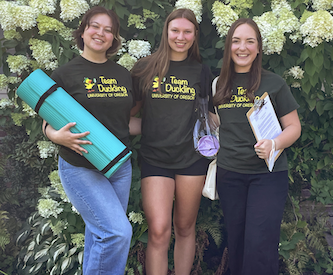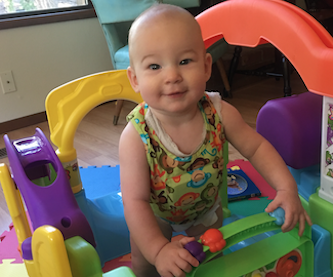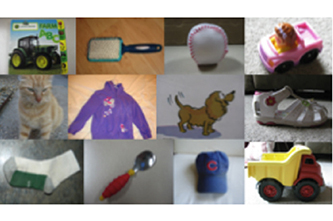Learning Lab research spotlight!
The feature space of everyday music in infancy
What do infants hear all day long? To find out, we invited families and their infants to participate in a fun study where their infant wore an audio recorder at home. We discovered that infants hear lots of different kinds of music! We also learned some details like infants hear more instrumental music than vocal music.
Listen to an example by clicking on a box. The boxes are arranged so that you can learn what vocal, instrumental, live, and recorded music sound like. Lighter boxes mean that this kind of music happened more often in the everyday lives of infants.
To learn more, check out our public music corpus!


An hour in the life
We are inviting families with babies (up to 2 years old) to participate in a study about the everyday lives of babies and their mothers in their home environment. Please visit an hour in the life!

What are the early auditory environments of infants and toddlers?
In this project, we are discovering what auditory information is available to young children during their typical activities. Infants and toddlers wear a soft vest with a lightweight audio recorder. Parents turn on the recorder when the child is awake so that we can discover what sounds happen during activities like mealtime and playtime. Knowing more about the everyday soundscape – and how it changes over the first few years of life – will help us understand how children build knowledge about the people, objects, and actions of our world.
Check out the spotlight (above)!
What are the early visual environments of infants and toddlers?
In this project, we are discovering what visual information is available to young children during their typical activities. Infants and toddlers wear a soft cap with a lightweight camera sewn in. Parents turn on the camera when the child is awake so that we can discover what appears during activities like mealtime and playtime. Knowing more about the information that appears in these scenes – and how it changes over the first few years of life – will help us understand how the human visual system gets built.
Play the video (left) to see developmentally ordered scenes. The video segments are from different children, ordered from younger to older. See also: Through a Toddler’s Eyes

What examples of objects go along with early words?
In this project, we are discovering how young children experience examples of categories that people talk about. Parents provide pictures of objects from their child’s everyday life along with details about how their child interacts with each object, and then children are tested in the laboratory for their recognition of familiar and unfamiliar instances of early object categories. Knowing more about how children experience examples with the same name will help us understand how the human conceptual system gets built.

How do the dynamics of play matter for early learning?
In this project, we are discovering how the structure of everyday interactions between caregivers and infants matter for what infants learn about objects. In some studies, caregivers and infants play with novel objects and in other studies they play with familiar objects. We analyze the rhythm of play including complex structure in how people look at, hold, and compare objects. Knowing more about these rhythms will help us predict how young children build skills in describing and recognizing objects.
UO Learning Lab Publications
Copyright notice. Clicking a link below is a request for a personal copy of the article and my delivery of a personal copy. Any other use is prohibited.
Franchak, J.M., Kadooka, K., & Fausey, C.M. (in press). Longitudinal relations between independent walking, body position, and object experiences in home life. Developmental Psychology. [Developmental Psychology] [osf]
Gonzalez, S.L., Xu, M., Herzberg, O., Jayaraman, S., Soska, K.S., Gilmore, R.O., Adolph, K.E., Casasola, M., Fausey, C.M., Frank, M., Goldin-Meadow, S., Gros-Louis, J., Iverson, J., Lew-Williams, C., MacWhinney, B., Naigles, L., Namy, L., Rowe, M., Soderstrom, M., Warlaumont, A., Yoshida, H., Yu, C., Yurovsky, D., & Tamis-LeMonda, C.S. (in press). Comparing apples to manzanas and oranges to naranjas: A new measure of English-Spanish vocabulary for dual language learners. Infancy. [Infancy][databrary]
de Barbaro, K., & Fausey, C.M. (2023). Mobile sensing in developmental science: A practical guide for researchers. In M.R. Mehl, M. Eid, C. Wrzus, G.M. Harari, & U.W. Ebner-Priemer (Eds.), Mobile Sensing in Psychology: Methods and Applications. Guilford Press.
Mendoza, J.K., & Fausey, C.M. (2022). Everyday parameters for episode-to-episode dynamics in the daily music of infancy. Cognitive Science, 46(8), e13178. [open access] [osf]
de Barbaro, K., & Fausey, C.M. (2022). Ten lessons about infants’ everyday experiences. Current Directions in Psychological Science, 31(1), 28-33. [open access]
Warlaumont, A.S., Sobowale, K., & Fausey, C.M. (2022). Day-long mobile audio recordings reveal multi-timescale dynamics in infant vocal productions and auditory experiences. Current Directions in Psychological Science, 31(1), 12-19. [open access]
Mendoza, J.K., & Fausey, C.M. (2021). Quantifying everyday ecologies: Principles for manual annotation of many hours of infants’ lives. Frontiers in Psychology, Developmental Psychology, 12, 710636. [open access] [osf]
Mendoza, J.K., & Fausey, C.M. (2021). Everyday music in infancy. Developmental Science, 24(6), e13122. [open access] [osf]
Anderson, H.T., Mendoza, J.K., Imhof, A., & Fausey, C.M. (2021). ITSbin: Wrangle LENA ITS Files into Linear Seconds & Minutes. R package version 1.0.0. https://doi.org/10.5281/zenodo.4474553 [GitHub]
Yoshida, H., & Fausey, C.M. (2019). Visual objects as they are encountered by young language learners. In J.S. Horst & J.K. Torkildsen (Eds.), International Handbook of Language Development. Routledge.
Mendoza, J. K., & Fausey, C. M. (2018). MendozaMusic HomeBank Corpus. doi: 10.21415/T47D-5K51 [HomeBank]
Fausey, C. M., & Mendoza, J. K. (2018). FauseyTrio HomeBank Corpus. doi: 10.21415/T5JM4R [HomeBank]
Carvalho, P., Vales, C., Fausey, C.M., & Smith, L.B. (2018). Novel names extend for how long preschool children sample visual information. Journal of Experimental Child Psychology, 168, 1-18. [pdf] [osf]
Jayaraman, S., Fausey, C.M., & Smith, L.B. (2017). Why are faces denser in the visual experiences of younger than older infants? Developmental Psychology, 53(1), 38-49. [pdf]
Fausey, C.M., Jayaraman, S., & Smith, L.B. (2016). From faces to hands: Changing visual input in the first two years. Cognition, 152, 101-107. [pdf] [databrary]
Jayaraman, S., Fausey, C.M., & Smith, L.B. (2015). The faces in infant-perspective scenes change over the first year of life. PLoS ONE, 10(5), e0123780. [open access] [databrary]
Smith, L.B., Yu, C., Yoshida, H., & Fausey, C.M. (2015). Contributions of head-mounted cameras to studying the visual environments of infants and young children. Journal of Cognition and Development, 16(3), 407-419. [pdf]
Fausey, C.M., & Matlock, T. (2011). Can grammar win elections? Political Psychology, 32(4), 563-574. doi: 10.1111/j.1467-9221.2010.00802.x. [pdf]
Fausey, C.M., & Boroditsky, L. (2011). Who dunnit? Cross-linguistic differences in eye-witness memory. Psychonomic Bulletin & Review, 18(1), 150-157. doi: 10.3758/s13423-010-0021-5. [pdf] [videos]
Fausey, C.M., Long, B.L., Inamori, A., & Boroditsky, L. (2010). Constructing agency: The role of language. Frontiers in Cultural Psychology. doi: 10.3389/fpsyg.2010.00162. [open access]
Fausey, C.M., & Boroditsky, L. (2010). Subtle linguistic cues influence perceived blame and financial liability. Psychonomic Bulletin & Review, 17(5), 644-650. doi: 10.3758/PBR.17.5.644. [pdf]
Marian, V., & Fausey, C.M. (2006). Language-dependent memory in bilingual learning. Applied Cognitive Psychology, 20(8), 1025-1047. doi: 10.1002/acp.1242. [pdf]
UO Learning Lab News
![]()
Follow us on Twitter: UO Learning Lab
June 2022: Team Duckling + Fausey win Impact Award from UO’s Office of the Vice President for Research and Innovation
Around the O
May 2022: Miko wins First Year Research Experience Award + Undergraduate Summer Research Award
UO CURE
UO Women in Graduate Sciences
June 2021: Anderson wins UO Women in Grad Sciences + UO Psychology Awards
UO Women in Graduate Sciences
August 2018: UO Learning Lab collaborates on PLAY initiative — open big data behavioral science
NYU News
November 2017: Through a toddler’s eyes on local NBC news!
KMTR
September 2017: UO Learning Lab undergraduate research featured!
CASCADE magazine
May 2017: Haskinson and Zhou win UO Women in Grad Science Summer Research Award
UO Women in Graduate Science
May 2017: Allison Zhou wins UO VPRI Undergraduate Fellowship
Fellowship recipients
May 2017: Sabrina Haskinson wins ICIS Undergraduate Summer Research Fellowship
International Congress on Infant Studies
May 2017: Fausey wins Ersted Award for Distinguished Teaching
Around the O
May 2017: Fausey & Mendoza win GRAMMY for research about everyday soundscape in infancy
Around the O
January 2017: Fausey calls for collaborative innovation in developmental science
Register-Guard
January 2017: Fausey speaks at UO Quack Chats
Around the O
Packed house at the Erb Memorial Union
August 2016: Fausey & Wehr join forces in order to understand how neurons become tuned to everyday sounds
UO Psych Dept Faculty GO! Proposals
June 2016: Mendoza wins Junior Scholar Travel Award, Best Practices Workshop, Infancy Conference
Workshop
June 2016: Mendoza wins Dixon Innovation Award
Dixon Innovation
November 2015: Maier wins Travel Award to Workshop on Extensive and Intensive Recordings of Children’s Language Experience
WEIRCLE
May 2015: Mendoza wins UO Women in Graduate Sciences Travel Scholarship
March 2015: Learning Lab joins National Living Lab Initiative
Eugene Science Factory
Living Lab Day with Team Duckling
February 2015: Mendoza on music and repetition
Daily Emerald
January 2015: Fausey on “The Visual Universe According to Babies”
OMSI Eugene Science Pub
Interested in working in the UO Learning Lab? Read on!
Undergraduate students. We are always looking for motivated students to help us make discoveries. There are many ways to contribute and there are many skills you will learn by working with us. We ask you to fill out a short application and also ask you to commit to working in the Learning Lab for at least two consecutive quarters. Please email Dr. Fausey if you are interested in helping us figure out how infants learn about words and objects!
*Download: UO Learning Lab Application
Graduate students. We invite applications from bright, motivated students who are interested in pursuing PhD research with Dr. Fausey and the UO Learning Lab! Students with research interests in cognitive development, language, vision, big data, and the statistical structure of early human infancy would be an excellent fit with current research efforts in the lab. Feel free to email Dr. Fausey with questions.
*See also: UO Psychology Prospective Graduate Students
Post-docs. Please email Dr. Fausey if you are interested in working as a post-doc research associate in the UO Learning Lab.
